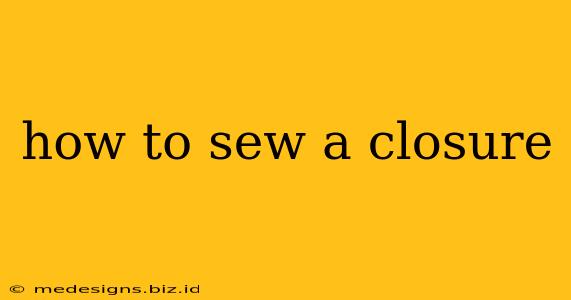Sewing closures might seem daunting, but with clear instructions and a little patience, you can master this essential sewing skill. This guide will walk you through the process, covering different closure types and offering tips for a professional finish. Whether you're working on clothing, bags, or other projects, knowing how to sew a closure is a valuable asset.
Understanding Different Closure Types
Before we dive into the sewing process, let's explore the common types of closures you might encounter:
1. Buttons and Buttonholes:
This classic closure is versatile and widely used. You'll need to create buttonholes (using a buttonhole foot on your sewing machine or by hand) and sew buttons securely onto the opposite piece of fabric.
Tips for sewing buttons: Use a button that complements your project's style. Secure the button with several stitches for extra durability. Consider using a shank button (one with a small gap between the button and the fabric) to prevent pressure points on thicker fabrics.
2. Zippers:
Zippers offer a smooth, secure closure, ideal for garments and bags. There are different types of zippers: invisible, metal, and plastic, each requiring slightly different techniques.
Tips for sewing zippers: Use a zipper foot for accurate stitching close to the zipper teeth. Pin carefully to avoid puckers and ensure even stitching. For invisible zippers, practice on a scrap of fabric first to perfect your technique.
3. Hook and Eye Closures:
These small, discreet closures are perfect for adding a touch of elegance and security. They usually consist of a hook that fastens into an eye.
Tips for sewing hook and eyes: Use a needle and thread suited to your fabric type for strong and reliable closure. Ensure the hook and eye are aligned correctly before sewing them down, testing the closure before finishing.
4. Snaps:
Snaps are easy to sew and provide a quick, secure closure. They are frequently used in bags, children's clothing, and other projects.
Tips for sewing snaps: Use the correct setting tool (often included with snap fasteners) to properly attach the snap pieces. Ensure that you press the snap firmly and consistently to make sure the parts are set properly.
5. Velcro:
Velcro is a widely used closure, particularly suitable for items needing a quick and easy fastening.
Tips for sewing Velcro: Choose the appropriate type of Velcro (hook and loop) for your project. Use a zigzag stitch or a strong straight stitch to secure it, particularly when working with bulky materials.
Step-by-Step Guide to Sewing a Basic Button and Buttonhole Closure
This guide focuses on buttons and buttonholes, a common and versatile closure type:
- Mark Buttonhole Placement: Use tailor's chalk or a fabric marker to precisely mark the buttonhole positions.
- Create Buttonholes: Use your sewing machine's buttonhole foot (following the machine's instructions) or hand-sew buttonholes (using a buttonhole stitch).
- Sew on Buttons: Place the button where you want to sew. Either hand-sew or use your machine (using a button-sewing foot) to sew the button securely in place using several stitches to secure the button to prevent the button from falling off.
- Test the Closure: Once the buttons and buttonholes are complete, test the closure to ensure a smooth and secure fastening.
Tips for Success:
- Use the right needle and thread: Choose a needle size and thread type appropriate for your fabric.
- Practice on scraps: Experiment with your chosen closure method on scrap fabric before tackling your actual project.
- Pin carefully: Secure all pieces with pins to prevent shifting during sewing.
- Press seams: Pressing your seams ensures a clean, professional finish.
By following these guidelines, you'll be able to confidently sew various types of closures, enhancing your sewing projects and boosting your skills! Remember that practice makes perfect, so don't be afraid to experiment and refine your technique.
